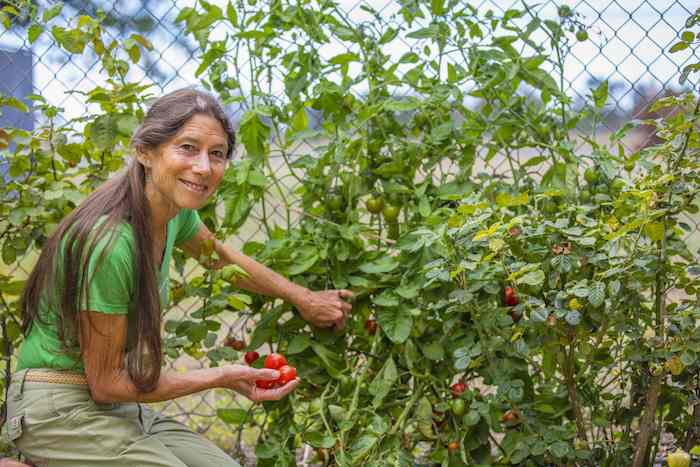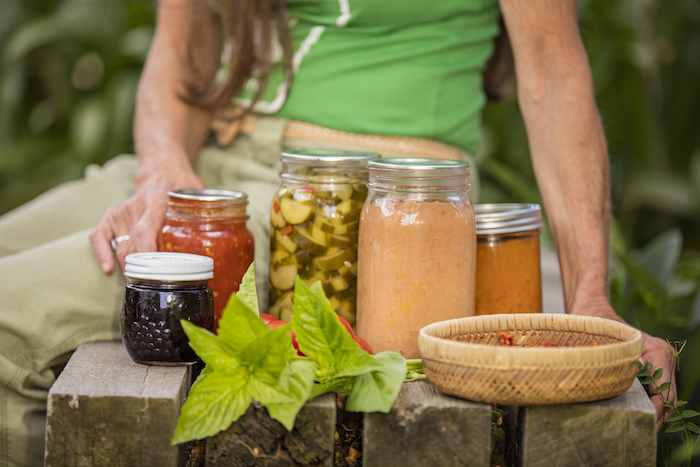Putting up the harvest doesn’t just fill our pantries—it preserves community.
Abundance is something we can influence, but not control. A bumper crop operates on its own schedule, forcing you to adjust yours. That’s where preservation comes in. Once a necessity for survival, food preservation—specifically that of vegetables and fruits—now carries a different kind of urgency, one that’s spiritual. Communing with locally grown food isn’t just about creating your own stash of BPA-free canned tomatoes or fermenting killer cider with which to impress your friends. It reminds us that we’re human, and dependent on nature for more than just food. The very act of preserving sends your soul to the spa.

Photo: Kristin Newsom
Those are the more abstract benefits of preserving the harvest at home. The concrete ones can be pretty great, too—better nutrition and flavor, lower cost. “It’s the nature of seasons that you have a lot of something,” says Wendy Krupnick, a longtime gardener, educator, and avid home preserver. An adjunct faculty member of Santa Rosa Junior College, she grows enough at the home she’s lived in for 16 years that she’s self-sufficient with vegetables.
The first secretary of the California Certified Organic Farmers organization and an innovator with Warren Weber’s Star Route Farms in Bolinas, Krupnick collaborated with Rosalind Creasy on the 1988 book Cooking from the Garden. “That’s what got me into preserving,” she says. “Gardening is the number one hobby in America. If you’re growing, it goes hand-in-hand.” Krupnick also gathers Himalayan blackberries and, using her food mill, makes them into seedless jam. “Here in California, food happens,” Krupnick says.
As the coordinator for SRJC’s four-acre market garden and through classes she’s taught over the years, Krupnick is a familiar face to aspiring canners in the North Bay. And for preservation newcomers, attending a class or demonstration can be very helpful. “Doing it with someone can demystify it,” says Krupnik, who preserves her harvest also by freezing and drying.
The recent surge of interest in home preservation is, in part, a reaction against our industrialized food system, but it reflects an increasing savviness about quality. “Self-sufficiency, knowing where food comes from, families are interested in that,” Krupnick says. She reports seeing a wide variety of attendees at her canning demonstrations, including a recent one at Sebastopol Hardware.
Canning is the method most people associate with preservation, but fermentation has the biggest buzz, perhaps because it’s both novel and elemental. Sandor Katz, a native New Yorker who decamped for a commune in Tennessee, has become America’s Pied Piper of fermentation through his books, workshops, and website Wild Fermentation—which is especially notable for its active user forum.
We made connections out of necessity. Jennifer Harris
On a local level, interest in fermentation is particularly robust. Jennifer Harris’ original desire to learn more about making kombucha prompted her to volunteer at the 2008 Freestone Fermentation Festival. “I knew nothing about fermentation, and I wanted to get some more hands-on knowledge,” she says. Clearly, the event whetted her passion as that festival evolved into the annual Farm to Fermentation Festival, which she has been running since 2011. It’s now held at Santa Rosa’s Finley Center each August to accommodate the many attendees.
Harris calls Sonoma County the “fermentation capital of America,” not necessarily for the volume as much as the cultural and culinary significance as well as community participation.
But preservation isn’t just about good things to eat. It makes a wonderful variety of libations, too. Harris cites the “amazing small companies that have come out of Sonoma County. There’s the revival of cider. Beer is blowing up. Half of the vendors who pour alcohol at the festival started out as home brewers.”
Food production has traditionally been a communal activity, and nothing brings us out of the isolation we experience in our day-to-day kitchen life like preservation. “We make connections out of necessity. It’s about breaking down barriers,” says Harris. “Many hands make light work.” This is true of snapping green beans, harvesting apples, and packing pickles into jars.
It’s also true of passing knowledge along; while information we quickly access online can encourage our efforts and go very far in terms of troubleshooting, there’s nothing like the energy that happens face-to-face. Harris began a free monthly meetup called Vital Alchemy, where people can come and discuss home fermentation. “Our group has grown from eight to 10 people at the beginning to over 60 people a month,” Harris says. Meetings often include a demonstration, and people will bring samples of what they have to share. “There’s so much magic that happens when people get together and eat. You get really earnest connections.”
Often, becoming conversant in one method will naturally lead to exploring another. It pays off to be polyamorous with preservation. Ferment some cucumbers into kosher pickles (no vinegar in those) and can others in a vinegar brine for long-term storage. Dehydrate some kale for kale chips and then cook the rest to freeze in small batches. Share with your friends. Remind them that you’ll gladly take the plums from their backyard tree off their hands.
As Krupnick says, food happens. Make the most of it.
Article Resources:
With Mei Ibach, Wendy Krupnick teachers a ‘From Farm to Table: The Bounty of Fall Harvest’ class at SRJC on Saturday, Sept. 26. communityed.santarosa.edu
Healdsburg SHED offers a fermented hot sauce class on Sunday, Sept. 13, at1pm, and hosts ongoing fermentation and preservation education. healdsburgshed.com
The Methods
Freezing
You’ve probably been practicing this method without even thinking of it as preserving. Freezers are part of the fabric of our lives; we pop foods in them as an afterthought. Humans have been freezing food in cold climates for millennia, but it’s only in industrial times that we’ve been able to freeze year-round. If you have space in your refrigerator and zip-top freezer bags, you’re ready to go.
PROS: Does not require much time or equipment. It’s energy-intensive in some ways, but your freezer is probably running in the first place, so why not take advantage of it?
CONS: Useless if the power goes out. Changes the texture of some foods.
BEST FOR: Green beans, corn, fruit, cooked greens. Tomatoes are controversial, but if you thaw a pack of frozen chopped homegrown tomatoes in February, you’ll be glad to have them.
Canning
Compared to other methods, canning is actually a newcomer to the food preservation scene. Consider this: canning originated because of a cash prize offered in France during the Napoleonic wars (the government was looking for a better way to keep its troops fed). In his 2012 book The Art of Fermentation, Sandor Katz writes, “Canning, a sterilization process that revolutionized food preservation in the 19th century…is the diametrical opposite of fermentation.” Fermentation preserves food by encouraging good bacteria to grow and create lactic acid, while canning kills all of the micro-organisms.
This isn’t a dig at canning, which is useful, versatile, and conjures up homespun images of grandmothers in calico aprons. But it’s more cutting-edge than you might think.
PROS: Home-canned goods don’t take up freezer or refrigerator space and can have a shelf life of years. Jars are cute and trendy and canned goods make handy last-minute gifts.
CONS: Energy-intensive. Changes the texture and flavor of some foods. Doing it makes your kitchen really hot. Requires some special equipment.
BEST FOR: Truly, it’s possible to safely can nearly any food if you have a pressure canner and know how to use it. Otherwise, stick to high-acid foods like vinegar pickles, fruit, tomatoes, and preserves like chutney, jams, and compotes.
Fermentation
What might be perhaps the original method of preserving food is having a moment. So many cornerstones of our food culture—from bread to yogurt to vinegar to beer—are fermented, and to discover that it’s possible to make this alchemy happen in your own home is empowering.
PROS: The most passive method of preservation. Results in micro-organisms that promote digestive health. Easy to do in small batches. Requires little, if any, start-up equipment. Transforms the flavor and texture of foods in exciting ways.
CONS: May require a lot of space if you plan to ferment big quantities. Certain fermented foods can be an acquired taste. Will extend the shelf life of many foods, but not as long as freezing or canning.
BEST FOR: Nearly anything, but cabbage is a good entry-level fermentation project, as is water kefir, if you have a lot of fruit.
Drying
Depending on what you want to dry, there are any number of ways to go about it; in addition to countertop dehydrators, there’s the oven, plus the tried-and-true “hanging food from a string” approach.
PROS: Results almost always trump store-brought dried foods. Time required is largely hands-off. Can be done using various methods.
CONS: A good dehydrator with a large capacity takes up a lot of space and is not cheap. It can be difficult to dehydrate and entire batch of a bumper crop of tomatoes or fruit. Yield can be small, but the flavor is intense.
BEST FOR: Herbs are the obvious one here, but orchard fruits, some tomatoes, lean beef, salmon, and some berries. Krupnick likes to dry zucchini chips. And don’t forget mushrooms.


